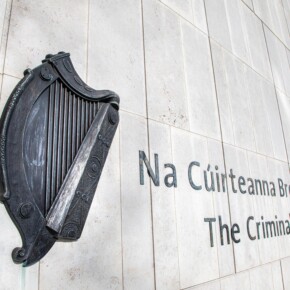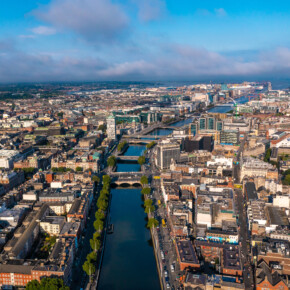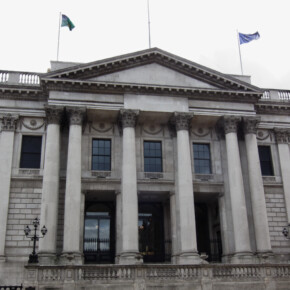Calls to expand Metrolink out to Knocklyon
Mike Finnerty 10 Apr 2024
The Metrolink hearings heard a variety of proposals in the final week of hearings, such as creating a tunnel for commuters and possibly expanding services out as far as Knocklyon.
The Metro South West Group told the hearing that the area should also benefit from Metrolink services and that merely expanding Luas services isn’t enough.
2022 Census statistics found that 355,000 people in the southwest of Dublin, but will not see the direct benefit of the Metrolink based on its current design.
Consisting of 40 residents’ associations between the Red and Green Luas lines, an oral presentation was delivered during the final week of Metrolink hearings discussing the need for rail services in the area.
The presentation heard that the current plans, which involve the Metrolink terminating at Charlemont, it would be possible to expand services to Terenure and beyond once the project is completed.
However, the group said, this would prevent a “double back” system which means that Portobello and Rathmines would be left out of future planning.
For this season, the group states, the Metrolink should not go any further south than St. Stephens’ Green and it should run from the west side of the park.
They said that Portobello and Rathmines are “densely populated” areas, yet they have no easy access to rail services.
“Duplicating the Luas Green line – by bringing MetrlLink to Charlemont – would provide negligible benefits, as residents in that area already have the Luas,” they said.
“Bypassing Portobello/Rathmines, as is now proposed by Transport Infrastructure Ireland, would reduce significantly the potential benefits of continuing Metrolink to south-west Dublin as a phase 2 project.”
Local resident Pauline Foster proposed a tunnel, similar to what is seen at Waterloo Station in London, as a way to connect the proposed station at Tara Street and a connecting station for south-west services.
A proposed 200 metre-long pedestrian tunnel under Burgh Quay, Foster said, would result in two fewer stations being excavated, would avoid the proposed demolition of houses adjacent to Tara Street, prevent disruption around Trinity College and would allow for St Stephens’ Green to be prepared for DART Underground infrastructure.
Foster said that the BART system in San Francisco as well as the aforementioned London Underground, already have tunnel infrastructure in place, and if the Metrolink was to be adequately future-proofed and cause less disruption a tunnel is “the way to go.”
“In our submission, we quoted an eminent railway engineer who estimated that the radius of curvature from the proposed Metrolink station at Tara Street to a possible location on the west side of St Stephens Green would be approximately 500m.”
She noted that that it would be “completely unremarkable” as many metro systems around the world have stretches of tunnel with a radius of curvature much smaller than the proposed design
“The BART in San Francisco and the Central Line of the London Underground (between White City and Shepherd’s Bush) are just two examples,” she told the hearing.
The group said that the proposed station at Charlemont is “unsuitable,” echoing concerns by Dublin Bay South TD Jim O’Callaghan.
An initial terminus at Sandyford was nixed, and the group proposed other terminus points such as O’Connell St North, Tara Street, St Stephen’s Green East and St Stephen’s Green West.
Current TII proposals show that 30 northbound Luas trams will arrive in Charlemont, but only 24 will proceed to St Stephen’s Green, due to a lack of road space on Adelaide Road and Harcourt St.
“As well as practical problems with this proposal, there are very serious safety issues,” the hearing was told.
“For example, if 6 inbound trams per hour simply reverse southwards from Charlemont, they will be departing from the wrong platform. Many southbound passengers transferring from Metrolink will surely seek to cross the Luas tracks to access these empty trams.”
“Similarly, many southbound Luas passengers on crowded trams may elect to leave the crowded tram at Charlemont and transfer to a reversing and empty southbound tram.”
“These are highly dangerous prospects,” they added.
The group drafted in Northern Irish transport expert Austin Smyth to lay out his proposals for Metrolink, and questioned a previous study that doubted the efficiency of expanding services to Knocklyon.
In his 100-page report, Smyth audited a 2021 feasibility study that was commissioned by the National Transport Authority about the possibility of expanding Metrolink services to Knocklyon.
Smyth’s audit found “the study did not provide for identification of a preferred route for a possible Metro line on the corridor, nor the suggestion of the preferred design on any section of the alignment considered. However, should the proposed Metro be regarded feasible and worthy of advancement, a further route option selection and design process would be required to advance specific proposals.”
Smyth stated that the south-west of Dublin suffers from a “significant public transport deficit” but expanding the services out as far as Knocklyon would cause “less disruption” to existing transport services such as the Luas Green line.
“It would have less permanent adverse impacts on the urban environment and on accessibility for residents and businesses than the upgrade of the Luas Green Line,” he noted.
“It is clear from Profesor Smyth’s report that there is a need to revisit continuing Metrolink to south-west Dublin before a decision is made by An Bord Pleanála to allow Metrolink to head towards Charlemont and Manders Terrace and thereby compromise the economic benefits of subsequently continuing Metrolink to south west Dublin.
The hearings, which ran between February and March, will now be taken into consideration by An Bord Pleanála and it is expected that a decision on planning permission will be granted within the next 6 months.











